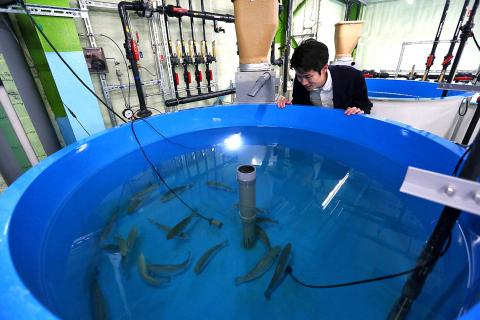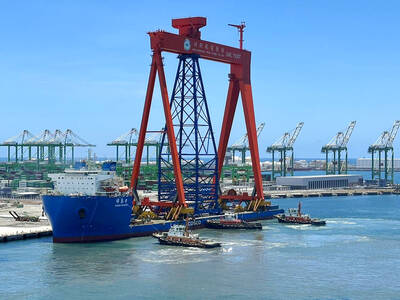Japan may be an island nation surrounded by the bounty of the sea, but businessman Tetsuro Sogo is looking inland to raise one of the country’s most loved sushi fish: salmon.
In a mountainous area near Tokyo, the water in a tank is a murk of writhing grey salmon, slithering past each other as they angle for food.
They are part of an experiment that Sogo, chief operating officer at FRD Japan, hopes will one day allow cost-effective inland farming of salmon, and enable Japanese to buy the homegrown fish for their sushi.

Photo: AFP
“We’ll be able to easily get quality salmon wherever we are,” Sogo said.
The majority of the salmon consumed worldwide is farmed, not wild, and the aquaculture market is dominated by Norway, which produces 1.3 million tonnes a year.
But farming at sea, the most common way to produce the fish, is a complicated prospect: the sea must be the right temperature — colder than 20 degrees Celsius — and only areas without strong waves and currents are suitable, normally inlets or bays.

Photo: AFP
Inland farming of salmon is often an impractical, expensive endeavor requiring lots of water and electricity to keep tanks clean.
That hasn’t stopped demand exploding since the 1980s, with the US, Russia, Europe and Japan all clamoring for the fish’s rich pink flesh, according to the World Wildlife Fund.
“Supply is not catching up with the growing demand,” said Sogo, speaking at his test facility in Saitama, 50km. Dressed in a suit like a typical Japanese salaryman, except for a pair of white rubber boots, Sogo carefully monitors the fish as though he is watching his own children.
“We thought we needed a new way to produce more salmon.”
KEEPING IT CLEAN
The company’s process is two-fold: first, simple tap water is converted to seawater by adding artificial sea salt, which allows the farming process to be set up anywhere tap water is available.
Second, a patented technology involving bacteria cleans the water, consuming the ammonia produced by the fish, and dissolving nitric acid, meaning energy-sucking cleaning systems are not necessary.
“We’ll be the world’s first successful case for this type of land-based salmon farming if we can turn a profit,” Sogo said.
The process was born out of technology developed by Sogo’s company for sewage disposal systems.
In 2008, they developed the breakthrough bacteria technology and the following year it was being used at an aquarium in Tokyo, at which point Sogo realized it could be used for salmon farming.
The innovation could be a massive boon for Japan, where a survey last year found salmon was the country’s favorite sushi fish.
It first began appearing in restaurants in Japan in the 1980s, after the Norwegian Seafood Council began a campaign to popularize it.
But Sogo hopes Japan can one day overtake Norway’s production, and export the technology to other consumers in the region.
“Asian markets are likely to grow bigger than the Japanese market,” said Sogo.
“We’re looking at the possibility of delivering fresh salmon there [through technology imports].”
SCALING UP
After a test run last year, which produced one tonne of salmon that was sold to a major supermarket in Tokyo, Sogo plans to have a larger pilot facility up and running by July in Chiba, near Tokyo, producing 30 tonnes a year.
By 2020, the firm is aiming for a commercial plant capable of producing 1,500 tonnes of sushi-ready salmon.
Sogo is far from the only salmon farmer in Japan: in 2015, the central city of Imizu started farming sakura-masu or “cherry blossom salmon,” named for their delicate color.
Rarely caught in the wild, the fish are considered a luxury product. But the city is farming the salmon using existing inland techniques, meaning running costs for water and electricity are high and capacity is relatively small — just 15 tonnes a year.
“We’ll boost production once we clear the capacity hurdle as there is a strong demand for this very tasty fish in the Tokyo area,” Tetsuya Murashita, a city official in charge of the project, said.
Seafood company Maruha Nichiro also built a plant last year to farm the prized salmon using a closed inland system, though it lacks Sogo’s patented technology.
Japanese salmon fans say they are eager to see locally produced fish available for sushi.
Wild-caught Japanese salmon is already popular locally for grilled dishes, but it is unsuitable for eating raw because it can harbor parasites not present in farmed salmon.
“I’d love it if I could eat made-in-Japan raw salmon,” said Megumi Yamanaka, a company employee in her 40s.
She added: “Imported salmon isn’t cheap. It would be great if I could buy cheaper and safer homemade salmon.”

The canonical shot of an East Asian city is a night skyline studded with towering apartment and office buildings, bright with neon and plastic signage, a landscape of energy and modernity. Another classic image is the same city seen from above, in which identical apartment towers march across the city, spilling out over nearby geography, like stylized soldiers colonizing new territory in a board game. Densely populated dynamic conurbations of money, technological innovation and convenience, it is hard to see the cities of East Asia as what they truly are: necropolises. Why is this? The East Asian development model, with

June 16 to June 22 The following flyer appeared on the streets of Hsinchu on June 12, 1895: “Taipei has already fallen to the Japanese barbarians, who have brought great misery to our land and people. We heard that the Japanese occupiers will tax our gardens, our houses, our bodies, and even our chickens, dogs, cows and pigs. They wear their hair wild, carve their teeth, tattoo their foreheads, wear strange clothes and speak a strange language. How can we be ruled by such people?” Posted by civilian militia leader Wu Tang-hsing (吳湯興), it was a call to arms to retake

This is a deeply unsettling period in Taiwan. Uncertainties are everywhere while everyone waits for a small army of other shoes to drop on nearly every front. During challenging times, interesting political changes can happen, yet all three major political parties are beset with scandals, strife and self-inflicted wounds. As the ruling party, the Democratic Progressive Party (DPP) is held accountable for not only the challenges to the party, but also the nation. Taiwan is geopolitically and economically under threat. Domestically, the administration is under siege by the opposition-controlled legislature and growing discontent with what opponents characterize as arrogant, autocratic

When Lisa, 20, laces into her ultra-high heels for her shift at a strip club in Ukraine’s Kharkiv, she knows that aside from dancing, she will have to comfort traumatized soldiers. Since Russia’s 2022 invasion, exhausted troops are the main clientele of the Flash Dancers club in the center of the northeastern city, just 20 kilometers from Russian forces. For some customers, it provides an “escape” from the war, said Valerya Zavatska — a 25-year-old law graduate who runs the club with her mother, an ex-dancer. But many are not there just for the show. They “want to talk about what hurts,” she